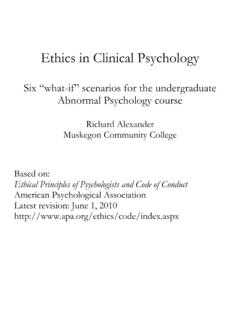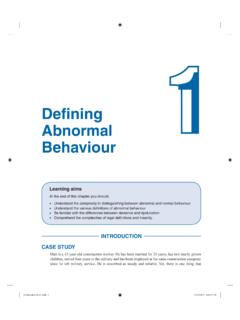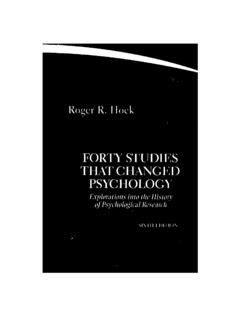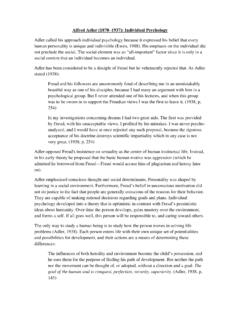Transcription of Abnormal Psychology - Washington State University
1 Discovering Psychology Series Abnormal Psychology 2nd edition Alexis Bridley, Lee W. Daffin Jr., Washington State University Version August 2020 Contact Information about this OER: 1. Dr. Lee Daffin, Associate Professor of Psychology 2. Dr. Alexis Bridley - Adjunct Instructor Table of Contents Preface Record of Changes Part I. Setting the Stage Module 1: What is Abnormal Psychology ? 1-1 Module 2: Models of Abnormal Psychology 2-1 Module 3: Clinical Assessment, Diagnosis, and Treatment 3-1 Part II. Mental Disorders Block 1 Module 4: Mood Disorders 4-1 Module 5: Trauma- and Stressor-Related Disorders 5-1 Module 6: Dissociative Disorders 6-1 Part III.
2 Mental Disorders Block 2 Module 7: Anxiety Disorders 7-1 Module 8: Somatic Symptom and Related Disorders 8-1 Module 9: Obsessive-Compulsive and Related Disorders 9-1 Part IV. Mental Disorders Block 3 Module 10: Eating Disorders 10-1 Module 11: Substance-Related and Addictive Disorders 11-1 Part V. Mental Disorders Block 4 Module 12: Schizophrenia Spectrum and Other Psychotic Disorders 12-1 Module 13: Personality Disorders 13-1 Part VI. Mental Disorders Block 5 Module 14: Neurocognitive Disorders 14-1 Module 15: Contemporary Issues in Psychopathology 15-1 Glossary References Index Record of Changes Edition As of Date Changes Made Fall 2017 Initial writing; feedback pending Spring 2018 Addition of Modules 2, 3, and 15 Summer 2018 Addition of Index, Glossary, and Preface; made minor edits based on student feedback.
3 Summer 2019 Proofreading edits August 2020 Proofreading edits and overall improvements such as end of section summaries and review questions. Added a Tokens of Appreciation page. Added lecture slides courtesy of Arizona State University . Tokens of Appreciation August 20, 2020 Alexis and I want to offer a special thank you to Ms. Celeste Ernst, undergraduate within the online Bachelor of Science degree in Psychology program, for her edits of the 1st edition during the spring 2020. Her changes, and our own, are integrated into the 2nd edition of the book and are a dramatic improvement over the 1st edition.
4 Thank you, Celeste. We would also like to extend a special thank you to Madeleine Stewart and Matt Meier, PsyD., of the Department of Psychology at Arizona State University for the development of the lecture slides for this book. They did this work unsolicited and produced top quality presentations which we will include in a password protected page, along with additional ancillaries such as an Instructor s Manual and test banks, in the very near future ( hopefully by mid fall semester at the latest but the slides in August) and for Instructors (Not students. Sorry). Thank you again for your excellent work, Madeleine and Matt.
5 It is more appreciated than you could ever imagine. And now to our reader. We hope you enjoy the book and please, if you see any issues whether typographical, factual, or just want to suggest some type of addition to the material or another way to describe a concept, general formatting suggestion, etc. please let us know. The beauty of Open Education Resources (OER) is that we can literally make a minor change immediately and without the need for expensive printings of a new edition. And it s available for everyone right away. If you have suggestions, please email them to either Alexis or myself (Lee Daffin) using the emails on the title page.
6 Enjoy the 2nd edition of Abnormal Psychology . Lee Daffin On behalf of, Alexis Bridley 2nd edition as of August 2020 Part I. Setting the Stage Topics Covered: 1. What is Abnormal Psychology ? 2. Models of Abnormal Psychology 3. Clinical Assessment, Diagnosis, and Treatment 2nd edition as of August 2020 1- 1 Part I. Setting the Stage Module 1: What is Abnormal Psychology ? 2nd edition as of August 2020 1- 2 Module 1: What is Abnormal Psychology ? Module Overview Cassie is an 18-year-old female from suburban Seattle, WA. She was a successful student in high school, graduating valedictorian and obtaining a National Merit Scholarship for her performance on the PSAT during her junior year.
7 She was accepted to a University on the opposite side of the State , where she received additional scholarships giving her a free ride for her entire undergraduate education. Excited to start this new chapter in her life, Cassie s parents begin the 5-hour c ommute to Pullman, where they will leave their only daughter for the first time in her life. The semester begins as it always does in late August. Cassie meets the challenge with enthusiasm and does well in her classes for the first few weeks of the semester, as expected. Sometime around Week 6, her friends notice she is despondent, detached, and falling behind in her work.
8 After being asked about her condition, she replies that she is just a bit homesick, and her friends accept this answer as it is a typical response to leaving home and starting college for many students. A month later, her condition has not improved but worsened. She now regularly shirks her responsibilities around her apartment, in her classes, and on her job. Cassie does not hang out with friends like she did when she first arrived for college and stays in bed most of the day. Concerned, Cassie s friends contact Health and Wellness for help. Cassie s story, though hypothetical, is true of many Freshmen leaving home for the first time to earn a higher education, whether in rural Washington stat e or urban areas such as Chicago and Dallas.
9 Most students recover from this depression and go on to be functional members of their collegiate environment and accomplished scholars. Some students learn to cope 2nd edition as of August 2020 1- 3 on their own while others seek assistance f rom their University s health and wellness center or from friends who have already been through the same ordeal. These are normal reactions. However, in cases like Cassie's, the path to recovery is not as clear. Instead of learning how to cope, their depression increases until it reaches clinical levels and becomes an impediment to success in multiple domains of life such as home, work, school, and social circles.
10 In Module 1, we will explore what it means to display Abnormal behavior, what mental disorders are, and how society views it both today and has throughout history. Then we will review research methods used by psychologists in general and how they are adapted to study Abnormal behavior/mental disorders. We will conclude with an overview of what mental health professionals do. Module Outline Understanding Abnormal Behavior Classifying Mental Disorders The Stigma of Mental Illness The History of Mental Illness Research Methods in Psychopathology Mental Health Professionals, Societies, and Journals Module Learning Outcomes Explain what it means to display Abnormal behavior.








